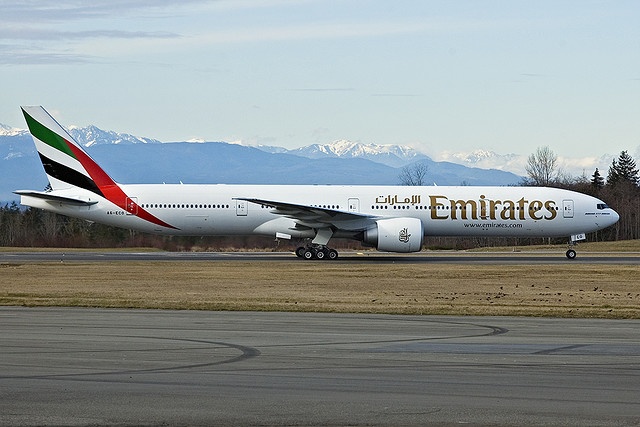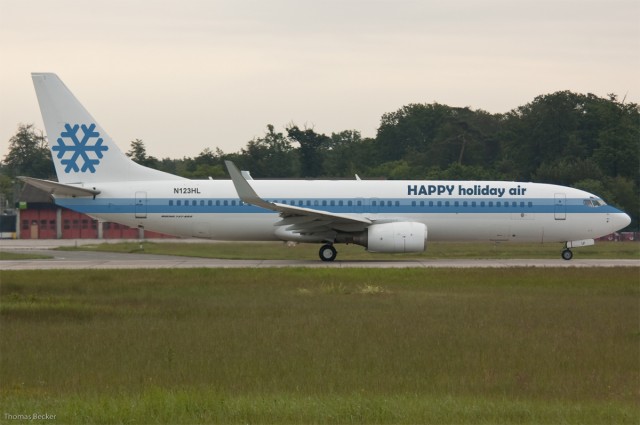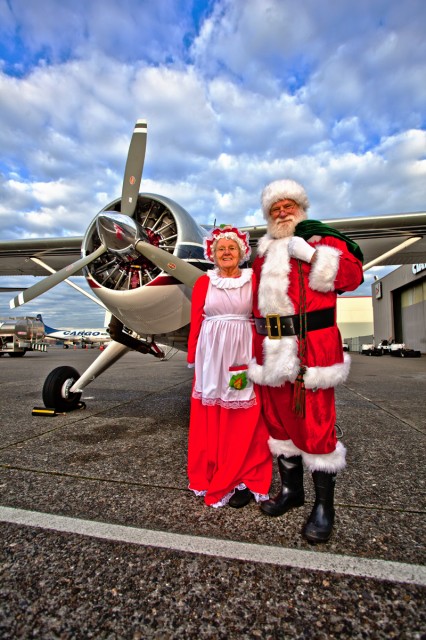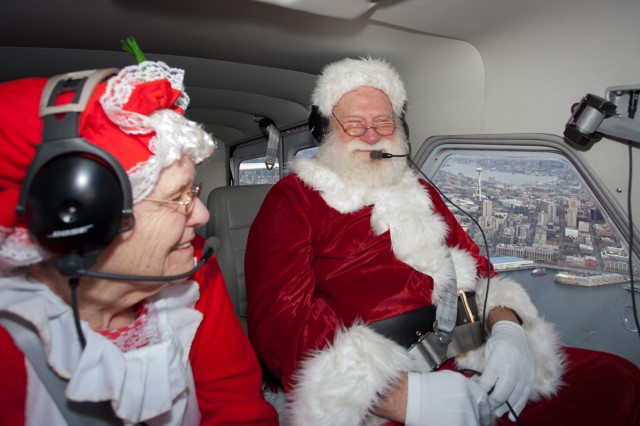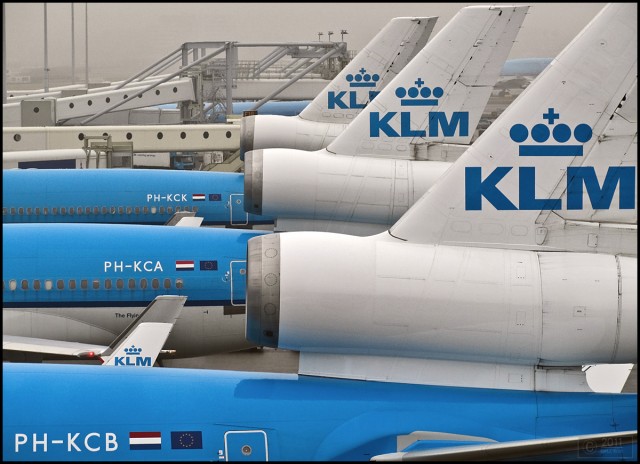How does Boeing paint their largest aircraft — well very carefully of course. This video, posted by Lufthansa, shows how Boeing went about painting a 747-8 Intercontinental (D-ABYA). The Lufthansa livery is very simple, but elegant at the same time. It looks right at home on a Boeing 747-8I.
Emirates is planning to start flights from Dubai International Airport (DXB ) to Seattle-Tacoma International Airport (SEA) on March 1, 2012. Being based in Seattle, it is going to be great seeing Emirates Boeing 777-300ER operating out of Seattle-Tacoma International Airport.
Really, this is going to be huge for Seattle. Emirates will offer a daily non-stop flight which takes only about 14-15hrs. This will be the only non-stop flight from Seattle to Dubai and even the shortest one-stop will take you about 20 hours each way. Even though I have not yet been able to fly on Emirates, I have heard their product and service are pretty darn slick, so the 15hrs should go by quite quickly.
Now is the time to find the best deals. Passengers are able to purchase tickets now, at quite a savings, to fly between March 1 to June 9, 2012. I did a quick search and it is no problem to get a round trip ticket for less than $1200.00 (with fees and taxes) during that time frame. The closest I can find on another airline is $100 more and takes 23.5 hours to get back home (it is also an American “legacy” airline and I would doubt it is as comfy as Emirates anyhow).
’œSeattle has always been an important feeder market and we are pleased to develop our relationship with the city,” Nigel Page, Senior Vice President of Emirates Commercial Operations in the Americas explained to AirlineReporter.com. “Not only will the new route help promote Dubai and transit markets to America’s Pacific Northwest, it will also promote tourism, business and leisure travel to the northwest United States from around the world. We are confident this new route will contribute to growth for the City of Seattle and for Dubai.’
Image: wings777
I hope you all have a great holiday season and safe travels. If you end up having an interesting airline story over the holiday — please share!
Original Image from Thomas Becker
Photoshopped by AirlineReporter.com
This story was written by John Harrell for NYCAviation and is being re-printed with permission…
SEATTLESanta Claus ditched his sleigh Saturday and flew in a 1952 de Havilland Beaver.
The jolly Christmas icon arrived at this city’s Museum of Flight aboard a restored single-prop aircraft dubbed ’œSanta One,’ greeting eager children and their parents with Mrs. Claus on a visit from the North Pole.
Santa decided to travel by plane instead of his traditional sleigh because his reindeer are unavailable during daylight hours, he said, and also because they need to rest for next week’s midnight marathon around the world.
’œRudolph and Dancer and Prancer and the rest, they’re resting up because they’ve got a big night’ on Christmas Eve, he said. ’œAnd it’s daytime, and they can’t fly in the daytime,’ he said.
Santa and Mrs. Claus had smooth sailing on approach to runway 13-R at King County International Airport (KBFI, ’œBoeing Field’), whose tarmac abuts the museum, on a chilly, partly-cloudy morning. The clear air afforded the Christmas couple wide views of the Puget Sound region on their approach past downtown Seattle and the Space Needle.
Santa Claus is familiar with Seattle from the air, since he sees the city from his sleigh once a year. But a mathematical analysis by NYCAviation suggests that his customary airspeed on Christmas Eve is far faster than the Beaver flew en route to the museum, in order to allow him to visit the countless houses of the world in a single night.
Santa One passed by the downtown core at only about 120 miles per hour, according to Douglas DeVries, vice chairman of the board of trustees for the Museum of Flight and the pilot of Santa One. While that’s a minuscule fraction of the average speed of Santa’s sleigh, DeVries called it ’œrocket-speed for a Beaver.’
The aircraft’s 59-year history has taken it to Hawaii, the Sound region, British Columbia, and points north, said DeVries.
It was badly damaged in Hawaii while a production piece in the 1998 feature film Six Days Seven Nights, said DeVries. The plane’s cockpit was compromised, he said, and its starboard wing had folded back toward the fuselage.
DeVries purchased the aircraft from a wrecking yard in Colorado, he said, and spent six years restoring the plane to airworthiness. He replaced almost all of its fuselage skin, except for one piece of the original, which he retained as a memento of the plane’s former life.
He also gave it its new tail numberregistry N67DNas a tribute to the movie it had helped make, DeVries said.
Santa Claus could almost have hopped aboard the airplane in 2008 when DeVries attempted to fly it to the magnetic north pole. DeVries’ trip was hindered by an iced-over waterway at a refueling stop, which prevented the ski-equipped airplane from landing there. DeVries finished the 12,000-mile arctic trip, but he would have to wait to speak to the North Pole’s chief resident in person.
Such a meeting took place Saturday, with Santa and Mrs. Claus seated in the mid-cabin row aboard DeVries’ restored Beaver. Removing their headsets, the Clauses climbed out of the plane to the welcome of their young admirers, who had turned out in scores for their arrival at the museum.
Moments later, the queue to meet Santa and Mrs. Claus inside the museum wrapped around much of the lower-floor exhibit. Elves in bright red and green ushered children forward to meet them beneath the cut-out USAir fuselage that forms part of the museum’s collection.
Santa’s helpers had been dispatched ahead of Santa One on an advance team, said Alexa, a 14-year-old elf, while ushering the long line of children awaiting their turn with Santa.
Alexa’s presence was ’œpart of an elf exchange program,’ she said. ’œI’m sent down here [from the North Pole] to make sure which kids are naughty or nice, and then I report back to Santa.’
She prefers Seattle to the North Pole. ’œIt’s always cold up there,’ she said. ’œYeah, I like snow, but I don’t like it constantly cold.’
’œMy favorite part was sitting on Santa’s lap,’ said Christopher, 5, of Puyallup, Wash., after his turn visiting Mr. and Mrs. Claus.
News of DeVries’ North Pole attempt in 2008 made its way to the Claus workshop, said DeVries. ’œSanta heard that we were trying to get to his house three years ago in the Beaver,’ which helped inspire the Claus couple’s interest in stopping at the museum, DeVries said.
’œWhat Doug wants for Christmas,’ joked wife Robbi DeVries with Santa present, ’œis his fuel back.’
The fuel, all 2,400 pounds of it, is still waiting to be reclaimed from the unreached stopover point, the pilot said.
Santa Claus did not immediately comment.
Notes: Character actors Clyde Bock and Mary Jane Donaldson contributed significantly to the unfolding of this story.
To view more photos, check out NYCAviation.com
In March of this year, KLM started service between Amsterdam (AMS) and Miami (MIA) using one of their MD-11 aircraft. Unfortunately, the route is not working out for the airline and in March 2012, the plug will be pulled.
“We will stop the route AMS-MIA per summer 2012 (as of March 25 2012),” KLM spokesperson explained to AirlineReporter.com. “With the start of a fourth daily frequency Atlanta-Amsterdam, we have a good indirect alternative within the Joint Venture with Delta.”
It is always sad to see a classic tri-holer pull out of a market. Sure, for an average passenger, I would imagine they would rather fly on one of KLM’s newer A330s, but for us aviation enthusiasts, the MD-11 is the classic bird of choice.
KLM is still operating 10 of the MD-11s in commercial service and seven in their cargo fleet (as of March 2011). They are the only airline in the world still running the MD-11 on scheduled passenger service.
When asked if there were any solid plans on replacing the MD-11, the airline stated, “KLM is continuously monitoring her fleet development, and at this moment KLM has no exact dates as yet to retire the MD-11.”
KLM still regularly flies the MD-11 to San Fransisco and Vancouver, so enjoy spotting them in North America while they are still around. With fuel prices continuing to rise, it is unclear how much longer we will be seeing the blue MD-11s.
Image: Chris 1971
